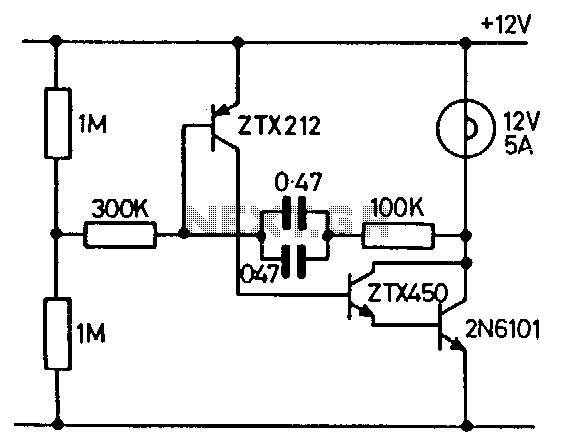
60W-flashing-light

The 2N6101 transistor should be mounted on a small heatsink. The 300 kΩ resistor controls the off period and might need to be adjusted if the transistor gains are high. The 100 kΩ resistor controls the on period.
The 2N6101 is a power transistor that requires effective thermal management due to its potential heat generation during operation. Mounting it on a small heatsink is essential to maintain its junction temperature within safe limits, thereby ensuring reliability and performance. The heatsink should be selected based on the expected power dissipation and the ambient temperature of the operating environment.
In the circuit configuration, a 300 kΩ resistor is utilized to manage the off period of the transistor. This resistor is critical in determining the duration for which the transistor remains in the non-conducting state. If the gain of the transistor is high, it may lead to an increased turn-off time, necessitating adjustments to the resistor value to achieve the desired timing characteristics. This adjustment is crucial for applications requiring precise control over switching times.
Additionally, a 100 kΩ resistor is employed to control the on period of the transistor. This resistor influences the time the transistor spends in the conducting state. The value of this resistor can be adjusted to tailor the on duration according to the specific requirements of the application, ensuring optimal performance and efficiency in the circuit.
Overall, careful selection and adjustment of these resistors are vital in ensuring the 2N6101 transistor operates effectively within its intended application, balancing the on and off periods while managing thermal conditions through appropriate heatsinking.The 2N6101 transistor should be mounted on a small heatsink. The 300-KO resistor controls tbe off period and might need to be adjusted if transistor gains are high. The 100-KO resistor controls the on period. 🔗 External reference
The 2N6101 is a power transistor that requires effective thermal management due to its potential heat generation during operation. Mounting it on a small heatsink is essential to maintain its junction temperature within safe limits, thereby ensuring reliability and performance. The heatsink should be selected based on the expected power dissipation and the ambient temperature of the operating environment.
In the circuit configuration, a 300 kΩ resistor is utilized to manage the off period of the transistor. This resistor is critical in determining the duration for which the transistor remains in the non-conducting state. If the gain of the transistor is high, it may lead to an increased turn-off time, necessitating adjustments to the resistor value to achieve the desired timing characteristics. This adjustment is crucial for applications requiring precise control over switching times.
Additionally, a 100 kΩ resistor is employed to control the on period of the transistor. This resistor influences the time the transistor spends in the conducting state. The value of this resistor can be adjusted to tailor the on duration according to the specific requirements of the application, ensuring optimal performance and efficiency in the circuit.
Overall, careful selection and adjustment of these resistors are vital in ensuring the 2N6101 transistor operates effectively within its intended application, balancing the on and off periods while managing thermal conditions through appropriate heatsinking.The 2N6101 transistor should be mounted on a small heatsink. The 300-KO resistor controls tbe off period and might need to be adjusted if transistor gains are high. The 100-KO resistor controls the on period. 🔗 External reference